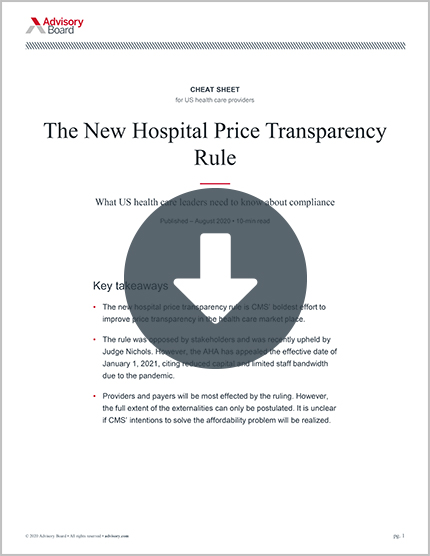As of last month, nearly two-thirds of the nation's largest hospitals are not in compliance with CMS's new price transparency rule. But this widespread lack of compliance may stem from hospitals' focus on addressing Covid-19, according to research published Tuesday in Health Affairs.
About the rule
According to CMS, hospitals under the new price transparency rule—which took effect in January—are required to post online "a machine-readable file…that includes all standard charges (including gross charges, discounted cash prices, payer-specific negotiated charges, and de-identified minimum and maximum negotiated charges) for all hospital items and services." Hospitals under the rule also will have to publicly post "discounted cash prices, payer-specific negotiated charges, and de-identified minimum and maximum negotiated charges for at least 300 'shoppable' services."
The rule also finalized methods for CMS to monitor hospital compliance with the requirements, as well as actions the agency can take against noncompliant hospitals—including warning notices, requesting corrective action plans, and levying civil monetary penalties that could equal as much as $300 per day. CMS can also publicize penalties against noncompliant hospitals under the final rule, and hospitals will be able to appeal the penalties.
Study findings
For the study, Morgan Henderson, an economist at the Hilltop Institute, and Morgane Mouslim, a policy analyst at the same organization, aimed to assess pricing data submitted by the nation's largest hospitals. However, when they started to dig into the data, they realized that not all the data was available.
"I was surprised," Henderson said. "I was looking forward to digging into the data and writing a paper." He added, "There are always lumps and bumps with new regulations—some posted files that were empty, some were password-protected. Is this accidental; is this intentional? I have no idea, but it was surprising how much variation there was in what actually got posted."
As a result, Henderson and Mouslim instead evaluated compliance with the rule among the largest 100 hospitals in the country, as determined by "certified bed count," between late January and early February 2021. Of the hospitals they assessed, the researchers found that 65—nearly two-thirds—were not complying with the rule. Specifically, they found that of noncompliant hospitals:
- 46 had no payer-specific rates posted, or the charges didn't include the name of the payer or plan;
- 12 failed to post any files, or they shared links to databases that were not downloadable
- 7 were noncompliant in other ways
Of the remaining 35 hospitals, Henderson and Mouslim found that 22 were compliant with the rule and 13 exceeded the rule's requirements.
Comments
Both the researchers and other industry stakeholders noted that hospitals are currently dealing with an unprecedented health care crisis amid the Covid-19 pandemic, which could have an impact on their ability to meet the rule's requirements, Modern Healthcare reports.
For instance, Henderson and Mouslim in their analysis noted that "hospitals are under strain (with Covid-19) and that complying with this regulation may be especially costly in this challenging period." The researchers acknowledged that many hospitals are in fact asking HHS to "exercise enforcement discretion with respect to the hospital price transparency rule…until the end of the public health emergency."
That said, Henderson and Mouslim wrote that they were "troubled" by how many hospitals were not in compliance, noting that because of the study's "purposefully conservative" approach toward assessing compliance, the "estimate of 65% noncompliance is almost certainly an underestimate." They encouraged "CMS to actively monitor [and incentivize] compliance," noting that they "strongly believe that compliance with this regulation is a necessary step for adding much needed price transparency into health care markets."
Separately, the American Hospital Association (AHA)—which, with other health care organizations, has filed a lawsuit against the price transparency rule—said the "subjective, oversimplified analysis" doesn't reflect hospitals' transparency efforts, nor does it recognize their work combatting the pandemic. "The same staff who would be needed to develop the lengthy machine-readable files required by HHS are also the staff who helped hospitals quickly reorient operations…for patients," AHA said (Kacik, "Transformation Hub," Modern Healthcare, 3/16; Henderson/Mouslim, Health Affairs blog, 3/16).
Are you 'non-compliant'? It's a trickier question than it may seem.
 By Christopher Kerns, Vice President of Executive Insights
By Christopher Kerns, Vice President of Executive Insights
"Compliance" can be a tricky word. Will HHS find an organization non-compliant if it has fulfilled 90% of its checklist? What about 60%? What about 99%, but the most important aspect—payer negotiated rates—is left unfulfilled?
The Health Affairs study acknowledges the squishiness of term "non-compliant." And the truth is that very, very few providers would find themselves 100% compliant with all aspects of the price transparency regulations—and it's unclear which guidelines CMS will deem essential when conducting provider audits. Much remains unknown.
But the study does get at a deeper truth: Many (perhaps most) providers are reluctant to post payer-negotiated rates, and few want to be the first to do so in a format that is easy to decipher (many are even making it difficult to find prices through a basic search engine).
This behavior doesn't stem from an unwillingness to comply with CMS per se, but rather old-fashioned game theory. Few organizations want to reveal their own prices unless and until their rivals do so. As in the classic prisoner's dilemma, if every organization in a market stays mum on payer-negotiated rates, it will be difficult for market forces to push those rates down (and in any event, it's not at all clear that greater transparency will push prices lower at all). The penalties aren't exactly trivial—$109,000 per facility per year—but they're also clearly not enough to motivate 100% compliance.
Our own sense is that most providers are (1) early in the journey toward embracing price transparency, (2) busy with other priorities, and (3) taking a wait-and-see approach.
How hard will CMS bring the hammer down on non-compliant organizations? How will greater transparency affect the first movers who have been quicker to fully comply? Will the new administration offer any delay or reprieve? And even if the Biden CMS takes an even tougher stance than the Trump CMS, will organizations have enough time to comply before the next audit? Until some of these questions are answered, we suspect we'll see a lot of provider organizations biding their time.
Don't miss out on the latest Advisory Board insights
Create your free account to access 1 resource, including the latest research and webinars.
Want access without creating an account?
You have 1 free members-only resource remaining this month.
1 free members-only resources remaining
1 free members-only resources remaining
You've reached your limit of free insights
Become a member to access all of Advisory Board's resources, events, and experts
Never miss out on the latest innovative health care content tailored to you.
Benefits include:
You've reached your limit of free insights



